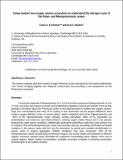Files in this item
Using modern low-oxygen marine ecosystems to understand the nitrogen cycle of the Paleo- and Mesoproterozoic oceans
Item metadata
| dc.contributor.author | Fuchsman, Clara | |
| dc.contributor.author | Stueeken, Eva Elisabeth | |
| dc.date.accessioned | 2021-09-10T23:40:18Z | |
| dc.date.available | 2021-09-10T23:40:18Z | |
| dc.date.issued | 2020-09-11 | |
| dc.identifier | 270188228 | |
| dc.identifier | 79f13b9a-331d-4a63-a5df-d1494afd5cd9 | |
| dc.identifier | 000567935700001 | |
| dc.identifier | 85091371432 | |
| dc.identifier.citation | Fuchsman , C & Stueeken , E E 2020 , ' Using modern low-oxygen marine ecosystems to understand the nitrogen cycle of the Paleo- and Mesoproterozoic oceans ' , Environmental Microbiology , vol. Early View . https://doi.org/10.1111/1462-2920.15220 | en |
| dc.identifier.issn | 1462-2920 | |
| dc.identifier.uri | https://hdl.handle.net/10023/23949 | |
| dc.description | CAF was funded by University of Maryland Horn Point Laboratory start-up funds. | en |
| dc.description.abstract | During the productive Paleoproterozoic (2.4–1.8 Ga) and less productive Mesoproterozoic (1.8–1.0 Ga), the ocean was suboxic to anoxic and multicellular organisms had not yet evolved. Here, we link geologic information about the Proterozoic ocean to microbial processes in modern low‐oxygen systems. High iron concentrations and rates of Fe cycling in the Proterozoic are the largest differences from modern oxygen‐deficient zones. In anoxic waters, which composed most of the Paleoproterozoic and ~40% of the Mesoproterozoic ocean, nitrogen cycling dominated. Rates of N2 production by denitrification and anammox were likely linked to sinking organic matter fluxes and in situ primary productivity under anoxic conditions. Additionally autotrophic denitrifiers could have used reduced iron or methane. 50% of the Mesoproterozoic ocean may have been suboxic, promoting nitrification and metal oxidation in the suboxic water and N2O and N2 production by partial and complete denitrification in anoxic zones in organic aggregates. Sulfidic conditions may have composed ~10% of the Mesoproterozoic ocean focused along continental margins. Due to low nitrate concentrations in offshore regions, anammox bacteria likely dominated N2 production immediately above sulfidic zones, but in coastal regions, higher nitrate concentrations probably promoted complete S‐oxidizing autotrophic denitrification at the sulfide interface. | |
| dc.format.extent | 1115488 | |
| dc.language.iso | eng | |
| dc.relation.ispartof | Environmental Microbiology | en |
| dc.subject | GE Environmental Sciences | en |
| dc.subject | SDG 14 - Life Below Water | en |
| dc.subject.lcc | GE | en |
| dc.title | Using modern low-oxygen marine ecosystems to understand the nitrogen cycle of the Paleo- and Mesoproterozoic oceans | en |
| dc.type | Journal item | en |
| dc.contributor.institution | University of St Andrews. School of Earth & Environmental Sciences | en |
| dc.contributor.institution | University of St Andrews. St Andrews Centre for Exoplanet Science | en |
| dc.identifier.doi | 10.1111/1462-2920.15220 | |
| dc.description.status | Peer reviewed | en |
| dc.date.embargoedUntil | 2021-09-11 |
This item appears in the following Collection(s)
Items in the St Andrews Research Repository are protected by copyright, with all rights reserved, unless otherwise indicated.

